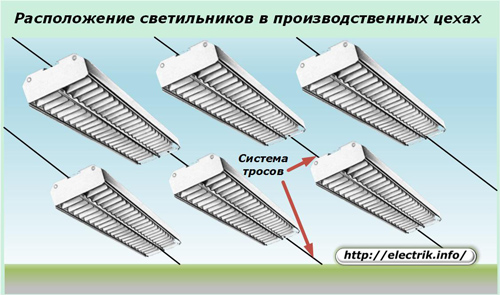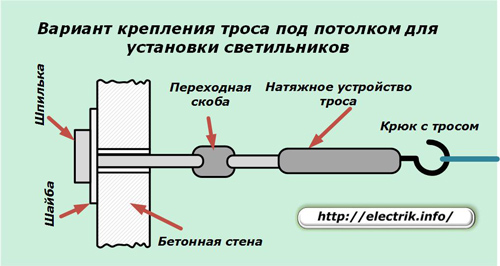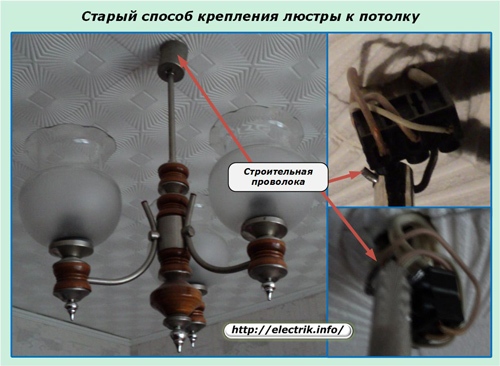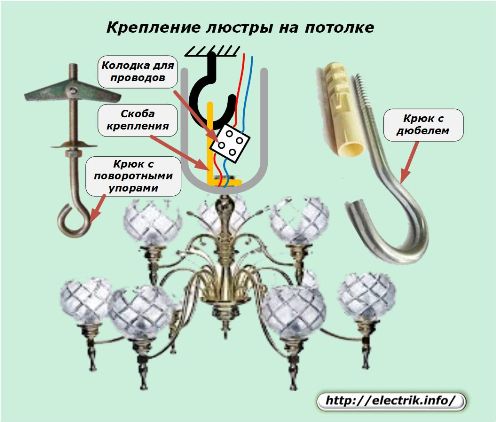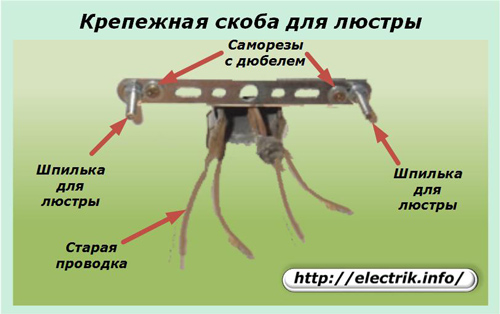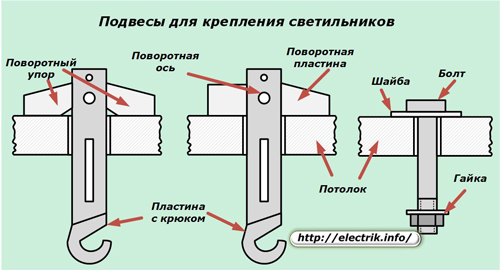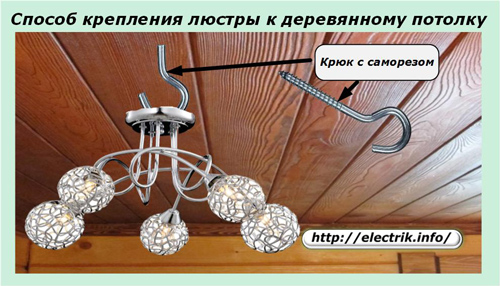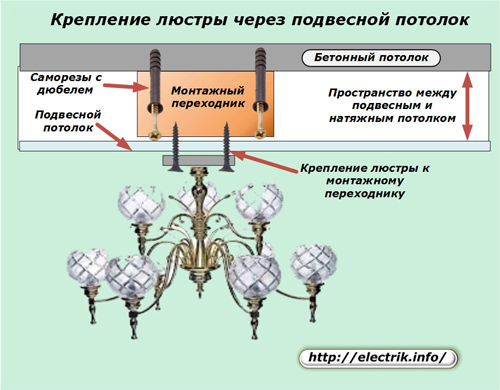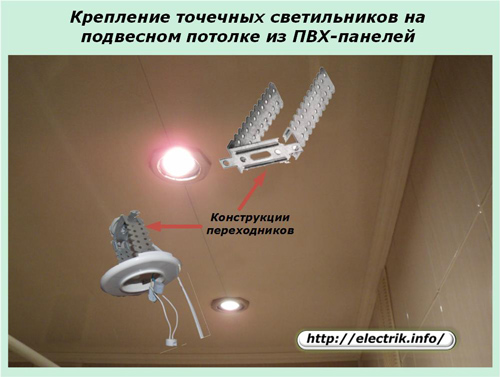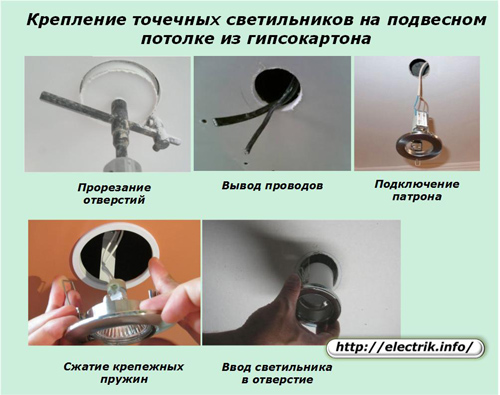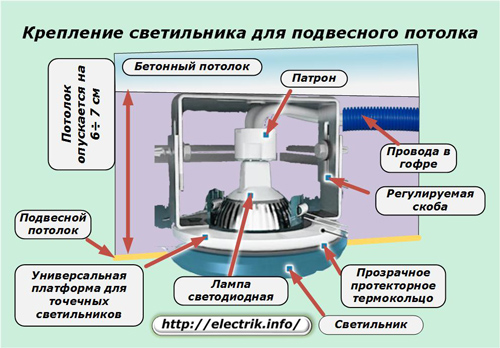Categories: Electrician at home, Electric installation work
Number of views: 57320
Comments on the article: 1
Ways to install fixtures on the ceiling
In the work of any electrical circuit, attention is always paid to its stability and installation quality. Lighting systems, especially those located above the head, must be firmly fixed in the power elements of the building and held in them under the influence of loads of various kinds.
The most common methods of installing fixtures on the ceiling can be conditionally divided by use:
-
at industrial facilities;
-
in residential premises.
Features of industrial lighting
In laboratories, workshops, workshops, light should evenly illuminate the entire workspace. For this, large-sized fluorescent lamps are often used, which are distributed in rows at a certain height.
The method of attachment may be different. Single devices are more convenient to fix directly to the ceiling surface.
However, the high height and the need to place a large number of such light sources creates certain difficulties during installation and their subsequent maintenance.
Therefore, the most commonly used cable system. Manufacturers even produce special designs of cable cables and wires for such lighting installations.
Such a system for placing fixtures allows you to free the ceiling from mounting additional structures on it and bring light sources closer to the surfaces of workplaces.
With this method, an additional load is created on the walls into which the fasteners are installed. Concrete slab buildings usually have a high margin of safety and withstand the forces applied to them. And masonry walls made of foam blocks or bricks have features. They must be tested for their ability to withstand the efforts of the tensioned cable and, if possible, use supporting columns for these purposes.
One of the options for attaching a cable system is shown in the picture below.
It provides a transitional bracket and a tensioner with a hook on which the cable is worn. It is advisable to choose a larger area of the washer located between the stud and the wall. Sometimes, in order to evenly distribute the load on the wall plane, metal plates or corners are installed instead of washers.
Ways to install fixtures on the ceiling in residential premises
The design, material and thickness of the ceiling affect the method of mounting artificial light sources on it.
Concrete ceilings from floor slabs
Fixing wire
In panel buildings of the old construction, builders in the place of installation of the lamp on the ceiling displayed not only electrical wiring, but also a piece of steel wire for installing a chandelier. On this building element, the lamp housing was also suspended.
Electricians had only to connect the wires from the chandelier to the electrical wiring through the junction box and close the junction with a decorative protective cap.
Hook
The same method works in most modern buildings. Only here the location of the chandelier, prepared by the builders, can not always satisfy the creative intentions of the owners who decided to fulfill the original design solution for lighting the room.
In this case, to hang the chandelier in a new place, you need to fix the hook. This fastener with different ceiling mounting methods can be found on sale.
The dowel hook has the simplest construction and installation method, but is suitable for ceilings made of concrete floor slabs. They need to drill a hole with a puncher with a diameter corresponding to the thickness of the dowel to the entire depth of its entry.
After that, the dowel is driven into the hole, and then the hook is screwed. When moving, it bursts the mounting sites of the dowel and firmly clamps it in the hole of the concrete slab.
Mounting bracket
This type of fastening resembles mounting a hook with a dowel, only the plate is fixed in at least two places with self-tapping screws and dowels. The holes on the chandelier body are inserted into the staples of the bracket and the decorative fastening nuts are screwed onto them.
Many modern chandeliers, especially of expensive designs with LED lamps, ribbons and remote control over the air via remote controls, are created for mounting on the ceiling in exactly this way. Moreover, the mounting bracket itself is part of the lighting kit.
A home master who decides to install such a lamp even at the location of the old chandelier will need to drill new holes and install a mounting bracket near the outlet of the electrical wires from the ceiling, as shown in the picture above.
Small thickness ceilings
The thin supporting structure of building elements sometimes does not allow the installation of fasteners in it to the full depth. For such a ceiling, mounting is used based on the insertion of the fixing plate through the entire thickness of the ceiling and fixing it on the outside. For this purpose, the following are used:
1. fixing hooks with swivel stops or plates;
2. Extra long bolts with thrust washers.
The second mounting option is somewhat simpler, but it can only be used where it is possible to insert the installation bolt into the ceiling hole from the top. This method is most often available during the construction of a building only at certain stages of construction, and after flooring on top of additional building materials, such an opportunity is lost.
Suspensions for mounting fixtures with swivel fasteners allow you to get out of this situation.
Their hooks are made of flat plates in which a hole is drilled and a rotary axis with movable stops is inserted. They are able to rotate vertically along the axis when entering the hook up through the hole in the ceiling, and then be horizontal and limit the lowering of this power element with the hook down.
The rotary plate in this position is located on both sides of the hole and firmly holds its surface hook in the ceiling. Movable stops work differently. Their design has a simple locking mechanism that prevents further rotation of the elements around the axis of rotation.
Wooden ceilings
The easiest way to fix the lamp is based on screwing a special hook with a self-tapping screw into the ceiling wood so that the length of the screw not only passes through the decorative board, but also turns out to be mostly screwed into the material of the supporting beam.
In this case, the maximum strength of the chandelier is achieved.
The fastening bases of small light fixtures can be screwed directly to the board with self-tapping screws 25 ÷ 35 mm long.
Dropped ceilings
To create them use:
-
drywall;
-
boards made of PVC materials;
-
stretch materials made of synthetic fabrics or films.
These materials cannot support the weight of most luminaires and will deform under the influence of the applied load. Therefore, to place light sources in them, special technical solutions are used.
Mounting the chandelier through suspended ceilings
Heavy luminaires are suspended on a solid concrete base of the ceiling slab using mounting transition structures, which are designed to transfer the weight of the chandelier to the base ceiling and the location of the base of the light source in the plane of the suspension.
The thickness of the mounting adapter is selected by the distance that is created from the base surface to the lower plane of the suspended ceiling.The methods for attaching the chandelier and the adapter may be different, but they must ensure the strength of the structure and its decorative appearance.
Typically, such work is performed during the installation of the ceiling. It is quite difficult to fix a heavy chandelier on an already finished and hung suspension structure, and in some cases it is problematic.
Installation of spotlights in the ceiling of PVC boards
Small light sources for creating local lighting are available on the basis of halogen, energy-saving fluorescent or led bulbs with cartridge designs adapted for placement in special fittings.
The loads created by them are much less than those that arise from the weight of the chandelier. For this reason, lightweight adapter designs are used. Conventional perforated galvanized iron mounting tapes are suitable for their manufacture.
They bend well and allow you to give any shape to the mount. At the same time, the strength characteristics of the created design ensure its reliable and long-term operation.
Installation of spotlights in a plasterboard ceiling
The strength of drywall sheets of various thicknesses allows the fastening of light sources for the material of the suspended ceiling, and not to the base plane of the main one.
When installing the lamp, the following sequence of work was adopted:
-
laying of electrical wiring for the electric cartridge on the main ceiling before mounting the pendant;
-
drilling holes in the fixture fixtures of the cartridge;
-
wire output;
-
cartridge connection;
-
compression of the mounting springs and the input of the lamp into the slotted hole.
The decorative covers of the cartridge cover the ends of the slotted hole, and the brackets with springs reliably hold the light weight of the lamp in the plasterboard ceiling.
Installation of spotlights in a stretch ceiling
The stretched fabric or film of a false ceiling does not allow to fix light sources in it. A special device is used for their installation.
The factory mount consists of two parts. One of them is screwed to the surface of the main ceiling with screws, and the second, based on the adjusting bracket and screws, allows you to set the level of the lamp on the plane of the tension material. It is desirable to place it at a distance of 6 ÷ 7 cm from the base surface.
The length of the wires is chosen so that it is convenient to connect a cartridge removed from the fittings to them.
A transparent tread thermo-ring is glued onto the stretched fabric at the point of contact with the universal platform. After the glue dries, the fabric inside the ring is cut. Through the created hole, the wires go out and the cartridge is connected to them. The assembled lamp is inserted inside the stretch ceiling and is fixed with spring clips.
The implementation of all work on the installation of luminaires on the ceiling requires attention and accuracy, which are ensured by knowledge of the technology and certain practical skills developed when handling professional tools and electrical devices.
See also on this topic:
Methods and layout of fixtures on the ceiling
Mounting fixtures on suspended and suspended ceilings
Features of installing LED lights on the ceiling
See also at e.imadeself.com
:

